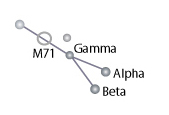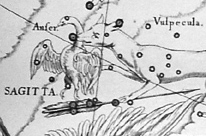Location: Northern Hemisphere
Coordinates:
Right Ascension: 18h
Declination: +20.2º
Source: Astronomers from Various Epochs - the Greeks, Romans, and Arabs.
The story behind the name:
Throughout history, the Sagitta constellation was generally referred to as the "arrow" in the native languages of the Greeks, Romans, and Arabs. The most popular label that endured the test of time is the Roman reference, Sagitta. In Greece, Sagitta was believed to be the arrow that Hercules used in the 11th of his famous 12 labors. For this task, Hercules was commanded by Eurystheus to bring back Zeus's golden apples.
After many searches and battles, Hercules crossed paths with a titan named Prometheus, a trickster who brought fire from the gods to Earth long ago. Zeus was furious over the action and chained Prometheus to a rock, where he was tortured by an eagle every day for decades. When Prometheus spoke with Hercules, he said he knew how to obtain the golden apples. As a trade for the knowledge Hercules was to free Prometheus from his torturous prison. Hercules agreed and slew Zeus's eagle with one arrow, Sagitta. In turn, Prometheus kept his part of the bargain and gave the secrets in obtaining the golden apples. After that, Hercules continued with his journey and eventually gave the golden apples to Eurystheus.
Other myths and legends are associated with this constellation, all related to arrows. Another story says Sagitta was an arrow shot by Sagittarius the Archer at Scorpius. Eratosthenes, an astronomer of the Hellenistic period, considered Sagitta to be the arrow from Apollo that dealt a killing blow to a Cyclopes in the story of Aeneid.
Introduction to Constellations | Constellation Sources | Constellations Index
Objects observed by Chandra in Cancer:



